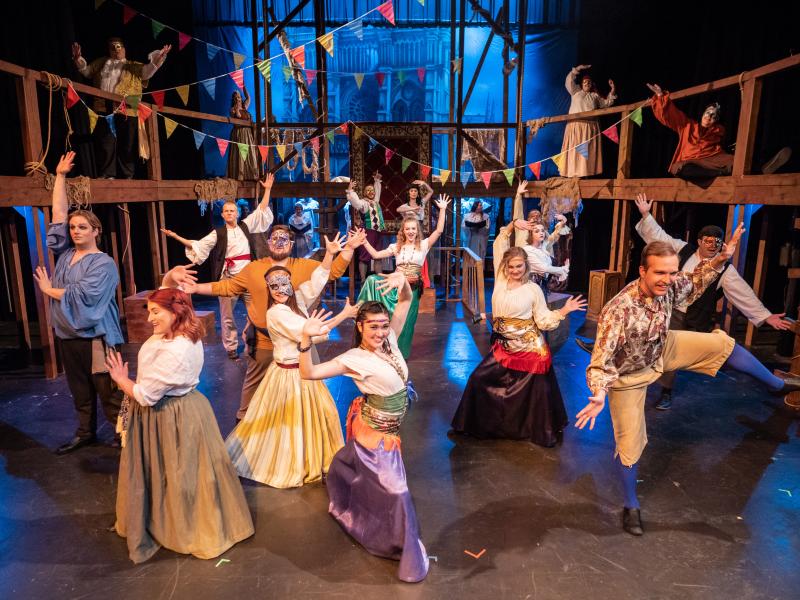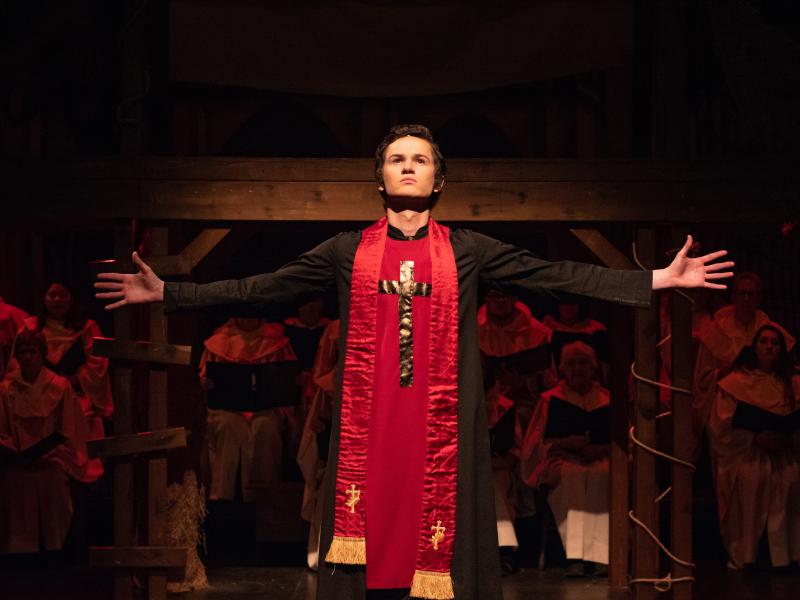Review: THE HUNCHBACK OF NOTRE DAME Proves Nothing's Changed in 500 Years at Midland University Kimmel Theatre

Victor Hugo's French Gothic novel of 1831 has been resurrected in the 21st century at Midland University Kimmel Theatre. THE HUNCHBACK OF NOTRE DAME with the Disney film songs written by Alan Menken (music) and Stephen Schwartz (lyrics) and book by Peter Parnell captures the richness of Hugo's tale of lust, acceptance, and the power of love in a way the animated film cannot. Under the direction of Dan P. Hays and Kyle Thomas, the cast and crew of Midland University Theatre do a fine job of presenting this meaningful piece of work in a way that is both entertaining and thought-provoking.
The story is set in 1482 France. It is the Feast of Fools, a day set aside where criminals may wander the streets freely. Quasimodo, a young man secreted away among the bells of the Notre Dame cathedral by Archdeacon Claude Frollo, can no longer resist the pull of the outdoors. He finds his way out of his seclusion only to be subjected to brutality by the crowd because he is, as Frollo tells him, "deformed and ugly." Frollo has warned Quasimodo that people would react this way to his appearance, and because he wants to teach him "I told you so," he allows the assault until the beautiful young gypsy Esmeralda interposes herself between the crowd and the hunchback. Esmeralda catches the lustful eye of Frollo as well as the attentions of Phoebus, a handsome young Captain of the guard. Add Quasimodo's instant adoration and there are now three men seeking her heart.

It is written that Hugo wrote his novel with the intent of ensuring Gothic architecture was retained in the renovations being done to the cathedral. Sadly, the recent fire did much to undo that. In this musical production, Frollo declares that he will "set Paris on fire." The timing is bitterly ironic.
The cathedral of Notre Dame is personified with living stone gargoyles who serve as Quasimodo's friends. One writer reported that there had been a real-life hunchback working on the cathedral restoration. It is likely that Hugo modeled his protagonist after him.
Although this musical does not follow Hugo's novel quite as well as a French version, NOTRE DAME DE PARIS, it carries the same themes which continue their relevance today. There is Frollo's sexual harassment and intimidation of Esmeralda using his powerful position to force her into compromising decisions. There is the public's abhorrence and abuse of someone who is physically different. There is the perception of good versus evil. There is the concept of sanctuary for those seeking asylum and as a place to hide. And there is the timeless beauty of sacrificial love.
Frollo claims a holy devotion to the church, but he falls victim to his own lust. He cannot contain his desire, so he deals in the only way he knows how: destroy what attracts him and remove the temptation. He gives himself credit for raising an unfortunate, yet treats Quasimodo like an imprisoned slave and verbally abuses him. Christopher Hernandez plays Frollo with a frostiness and rigid disdain for others, singing "Hellfire" in a chilling baritone.

Quasimodo, whose name has come to represent a "courageous heart beneath a grotesque appearance," is played well by Andrew Schwimmer. Like Quasimodo, Schwimmer starts off rather hesitantly, but grows steadily throughout until he projects the power the gargoyles tell him he needs with a superlative rendition of "Made of Stone."
Brett Ashley plays a sweet, but feisty Esmeralda. She reveals a compassionate heart, an unwillingness to compromise her ideals, and the rare ability to look at the inside of a person rather than the outside. In "God Help the Outcast" Ashley shines. Her timing, phrasing, and tone are perfection. She sells the song as she sells her character-- effortlessly.
Ashley and Roger Bunnell (Phoebus) merge their voices in heavenly harmony in "Someday." Zacheus Stewart (Clopin)'s fine tenor is also a very welcome addition to the show. The choir, directed by Dan P. Hays, at times raises the hair on my arms for its beauty. Robed in white and highlighted by artistic lighting, the choir scenes achieve a nearly angelic experience.
Bill Kirby's set fills the entire stage with much to appreciate. The pieces are utilitarian yet aesthetically pleasing. The rugs and special effects are especially nice touches which can be whisked away or illuminated as appropriate. Combined with lighting by co-designers Spence Schaefer and Pierce Bonacci-Johnson, and costumes by designer Lee Meyer, it all works to create a feeling of being transported back to an unfamiliar time and place.
Choreographer Kyle Thomas has dreamed up clever movement which makes watching the performance even more captivating. There is something to see each moment from curtain to curtain.
I was intrigued by the use of drawing charcoal on the faces of the performers. As a thematic element it could represent the fine line between stone figures personified as persons and persons who possess hearts of stone. Just that little bit of gray changes our perceptions of our world as we look upon those faces.
THE HUNCHBACK OF NOTRE DAME examines what makes a monster and what makes a man. We may never have the answer but as a line in the show says, "Someday life will be kinder and love will be blinder."
Photos courtesy of Midland University Performing Arts.
Videos

